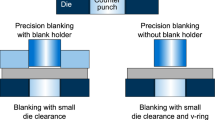Abstract
Incremental Sheet-Bulk Metal Forming offers an innovative and flexible approach for the manufacturing of gears. An insufficient formfilling of the generated gearing, especially of the first tooth formed, is observed. Aiming for a formfilling improvement of the first tooth element, three influencing factors were investigated. First, the prevailing friction is analyzed and a possibility for its adjustment is offered by a tailored adaption of the tool surface topographies. These were manufactured by micromilling, EDM and polishing processes and partially covered by CrAlN PVD-coatings. Based on ring-compression tests, which were performed to determine the resulting friction conditions, the analyzed topographies were transferred onto real tool surfaces and used in the incremental gear forming process. Second, the influence on the formfilling of the blank cutting process and the resulting sheet edge properties were investigated. The third aspect to enhance the formfilling of the gear elements was the modification of the process strategy of the incremental forming process. Due to different conditions for the initial and the following indentations, a preforming operation was investigated in order to realize a similar material flow for all indentations. With the combination of the best parameters regarding the tool surface, the blank cutting process and the forming strategy, an improvement of the formfilling of the first formed gear element by up to 33% and for the following gears by up to 13% was achieved.














Similar content being viewed by others
References
Merklein M, Allwood JM, Behrens B-A, Brosius A, Hagenah H, Kuzman K, Mori K, Tekkaya AE, Weckenmann A (2012) Bulk forming of sheet metal. CIRP Ann Manuf Technol 2:725–745
Mori K, Nakano T (2016) State-of-the-art of plate forging in Japan. Prod Eng 10(1):81–91
Bragança IMF, Silva CMA, Alves LM, Martins PAF (2017) Lightweight joining of polymer and polymer-metal sheets by sheet-bulk forming. J Clean Prod. doi:10.1016/j.jclepro.2017.01.049
Sieczkarek P, Kwiatkowski L, Ben Khalifa N, Tekkaya AE (2013) Novel five axis forming press for the incremental sheet-bulk metal forming. Key Eng Mater 554–557:1478–1483
Gröbel D, Schulte R, Hildenbrand P, Lechner M, Engel U, Sieczkarek P, Wernicke S, Gies S, Tekkaya AE, Behrens B-A, Hübner S, Vucetic M, Koch S, Merklein M (2016) Manufacturing of functional elements by sheet-bulk metal forming processes. Prod Eng 10(1):63–80
Sieczkarek P, Wernicke S, Weddeling C, Martins PAF, Tekkaya AE (2016) Local forming of gears by indentation of sheets. J Eng Manuf. doi:10.1177/0954405416654190
Sieczkarek P, Wernicke S, Gies S, Martins PAF, Tekkaya AE (2016) Incipient and repeatable plastic flow in incremental sheet-bulk forming of gears. Int J Adv Manuf Technol 86:3091–3100
Godi A, Grønbæk J, Chiffre DEL (2016) Characterisation and full-scale production testing of multifunctional surfaces for deep drawing applications. CIRP J Manuf Sci Technol 16:64–71
Wagner R, Völkl R, Engel U (2008) Tool life enhancement in cold forging by locally optimized surfaces. J Mater Process Technol 201:2–8
Kitamura K, Makino T, Nawa M, Miyata S (2016) Tribological effects of punch with micro-dimples in blanking under high hydrostatic pressure. CIRP Ann Manuf Technol 65(1):249–252
Pettersson U (2005) Surfaces designed for high and low friction. Dissertation, Uppsala University, Sweden (ISBN 91-554-6278-2)
Kersting P, Gröbel D, Merklein M, Sieczkarek P, Wernicke S, Tekkaya AE, Krebs E, Freiburg D, Biermann D, Weikert T, Tremmel S, Stangier D, Tillmann W, Matthias S, Reithmeier E, Löffler M, Beyer F, Willner K (2016) Experimental and numerical analysis of tribological effective surfaces for forming tools in sheet-bulk metal forming. Prod Eng 10(1):37–50
Sieczkarek P, Wernicke S, Gies S, Tekkaya AE, Krebs E, Wiederkehr P, Biermann D, Tillmann W, Stangier D (2016) Wear behavior of tribologically optimized tool surfaces for incremental forming processes. Tribol Int 104:64–72
Tillmann W, Vogli E, Herper J, Haase M (2010) Nanostructured bionic PVD-coatings for forming tools. Key Eng Mater 438:41–48
Male AT, Cockcroft MG (1964) A method for the determination of the coefficient of friction of metals under condition of bulk plastic deformation. J Inst Metal 93:38–46
Hense R, Wels C, Kersting P, Vierzigmann U, Loeffler M, Biermann D, Merklein M (2015) High-feed milling of tailored surfaces for sheet-bulk metal forming tools. Prod Eng Res Dev 9(2):215–223
Acknowledgements
The authors hereby thank the German Research Foundation (DFG) for the financial support of the transregional collaborative research center TR73 “Manufacturing of complex functional components with variants by using a new sheet metal forming process–Sheet-Bulk Metal Forming”. This work results from the cooperation of the subprojects A4 (“Fundamental research and process development for the manufacturing of load optimized parts by incremental forming of metal sheets”), B2 (“Machining of molds with filigree structures for Sheet-Bulk Metal Forming”) and B5 (“Application of nanostructured bionic thin layers to enhance the wear and friction behavior of forming tools by thin-walled sheet forming”). The authors, furthermore, would like to thank Dr. Carlos Silva from Instituto Superior Técnico in Lisbon for the support in the conduction of the experiments and Joshua V. Grodotzki for his valuable support.
Author information
Authors and Affiliations
Corresponding author
Rights and permissions
About this article
Cite this article
Sieczkarek, P., Wernicke, S., Gies, S. et al. Improvement strategies for the formfilling in incremental gear forming processes. Prod. Eng. Res. Devel. 11, 623–631 (2017). https://doi.org/10.1007/s11740-017-0764-1
Received:
Accepted:
Published:
Issue Date:
DOI: https://doi.org/10.1007/s11740-017-0764-1




